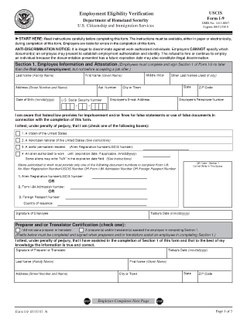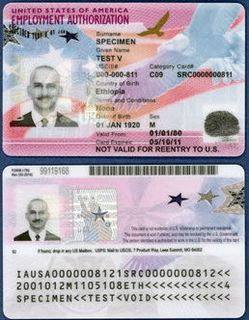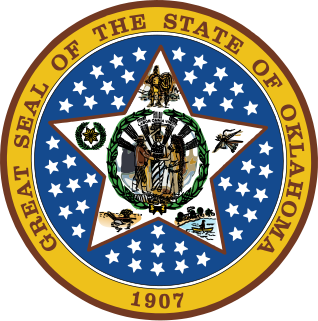The Georgia Security and Immigration Compliance Act requires that all public employers, contractors and subcontractors register and comply with the federal work authorization program operated by the United States Department of Homeland Security to verify new employee work eligibility.
On April 17, 2006, The Georgia Security and Immigration Compliance Act (GSICA) was authored by Georgia State Senator Chip Rogers, carried in the House by Georgia State Representative John Lunsford and signed into law by Georgia Governor Sonny Perdue. The Law later took effect on July 1, 2007. [1]
The GSICA required that all public employers, contractors and subcontractors register and comply with the federal work authorization program operated by the United States Department of Homeland Security to verify new employee work eligibility. [2]
The GSICA was created in an effort to address illegal immigration problems in the following areas: private employment, public employment and contracting, public safety, and public benefits.
It prevents any business from claiming certain wages paid to unauthorized employees as permissible business expense for state income tax purposes. [3] The law requires citizenship verification for individuals older than the age of 18 who are receiving local, state, or federal benefits. In addition, authorities are obligated to verify the immigration status of any foreign national who receives jail time for a felony or DUI. If found to be in the country illegally authorities are to report unauthorized individuals to the Department of Homeland Security. [1] The GSICA also provides modifications to the criminal code making it a felony to participate in or be affiliated with the trafficking of individuals for labor or sexual slavery. [3]
I. Citizenship Verification
Requires that all individuals receiving benefits from the state sign either an affidavit stating that they are a citizen of the United States or a legal alien. [1]
II. Employee Verification
Requires all public employers, contractors and subcontractors to verify new employee information by entering it into the federal database, also referred to as the Federal Basic Pilot Program. [2]
III. Tax Benefit Prohibitions
Annual wages of over $600 a year from undocumented employees are prohibited from being claimed as an allowable business expense for state income tax purposes. [1]
IV. Tax Withholding Requirement
Excluding federal tax withholding, a 6 percent state withholding tax is required for 1099 employees who fail to do the following: provide a taxpayer identification number, provide a correct taxpayer identification number, or provide a nonresident taxpayer identification. [1]
V. Law Enforcement
Authorities are responsible for enforcing federal immigration and customs laws to those found not to be in the country legally. [1]
VI. Human Trafficking
If found guilty of human trafficking or contributing, a felony punishable by 1–20 years imprisonment or 10–20 years for victims under age 18 will be enforced. [1]
VII. Citizenship Verification for Individuals Charged with Felony or DUI
Requires that the legal status of individuals charged with a felony or DUI be verified to prove U.S. citizenship. If an individual is proven to be an illegal resident notification to Immigration and Customs Enforcement is required. [3]
VIII. Immigration Assistance
Non-attorneys in the business of providing assistance to immigrants are required to post signs stating that they are not allowed to give legal advice and are not lawyers. [3]
The power to regulate immigration has been thought to be exclusively federal, however, states and localities have played a role as well in the regulation of immigration. In the twentieth century states have exercised their right to enforce restrictions on the access immigrants have regarding state benefits such as welfare as well as public employment restrictions that were placed on employers who hired unauthorized workers. [4] State and local efforts that have been made to prohibit employers from hiring unauthorized workers have two key historical features in common: First, it is declared unlawful to knowingly recruit, hire for employment, or continue to employ any individual who is an illegal worker. Second, employers are required to enter all employee information in the federal government's E-Verify program. [4]
Historically, state and local governments have sought to enter cooperative agreements with the federal government that would allow local law enforcement authorities to enforce federal immigration law directly. Laws have also been passed requiring police to report the immigration status of those arrested or detained for serious crimes. When public officials, including police, become involved in immigration enforcement, law enforcement is then compromised. The question then becomes whether or not the state and local police have been awarded inherent constitutional authority authorizing the arrest of immigrants who are in violation of federal immigration law. [4]
In 1996 Congress amended the Immigration and Nationality Act adding Sec. 287(g) which gave authorization to state and localities to enter into agreements with the federal government that would give state and local officials authority to arrest and detain individuals accused of violating federal immigration laws. [4] States and localities that agreed with this addition to the Immigration and Nationality Act received special training and required supervision by Immigration and Customs Enforcement. [4]
There is a history of problems associated with the federal government entering agreements with state and local law enforcement agencies that give them permission to identify individuals who are in the country illegally. Both legal and illegal immigrants are susceptible to exploitation by the power given to law enforcement to exercise the Immigration and Customs Enforcement (ICE). In fiscal years 2006–2008, ICE received about $60 million to train, supervise, and equip program participants. [5] As of October 2008, ICE reported enrolling 67 agencies and training 951 state and local law enforcement officers. The ICE has [5] created some management controls that allow it to govern Sec 287(g) that are in some ways flawed and limited. [5] The program lacks documented objectives which allows for inconsistency in its practice, and it also requires supervision but does not describe the nature and extend of that supervision. [5] This allows for local law enforcement to act on instinct and personal prejudices without fear of consequence, which has led to community fears of racial profiling and intimidation. [5] State and local participation in immigration enforcement have raised policy concerns. [4] It creates policy dangers such as the risk of racial profiling by employers and police which directly affect immigrants and surrounding communities. [4]

The Immigration Reform and Control Act was passed by the 99th United States Congress and signed into law by US President Ronald Reagan on November 6, 1986.
Immigration reform in the United States is a term used in political discussion regarding changes to current immigration policy of the U.S.
The Border Protection, Anti-terrorism, and Illegal Immigration Control Act of 2005 was a bill in the 109th United States Congress. It was passed by the United States House of Representatives on December 16, 2005 by a vote of 239 to 182, but did not pass the Senate. It was also known as the "Sensenbrenner Bill," for its sponsor in the House of Representatives, Wisconsin Republican Jim Sensenbrenner. The bill was the catalyst for the 2006 U.S. immigration reform protests and was the first piece of legislation passed by a house of Congress in the United States illegal immigration debate. Development and the effect of the bill was featured in The Senate Speaks, Story 11 in How Democracy Works Now: Twelve Stories a documentary series from filmmaking team Shari Robertson and Michael Camerini.
Illegal immigration to the United States is the process of migrating into the United States in violation of federal immigration laws. This can include foreign nationals who have entered the United States illegally, as well as those who entered legally but then remained after the expiration of their entry visa or parole documents. Illegal immigration has been a matter of intense debate in the United States since the 1980s.
The Comprehensive Immigration Reform Act was a United States Senate bill introduced in the 109th Congress (2005–2006) by Sen. Arlen Specter [PA] on April 7, 2006. Co-sponsors, who signed on the same day, were Sen. Chuck Hagel [NE], Sen. Mel Martínez [FL], Sen. John McCain [AZ], Sen. Ted Kennedy [MA], Sen. Lindsey Graham [SC], and Sen. Sam Brownback [KS].

Form I-9, officially the Employment Eligibility Verification, is a United States Citizenship and Immigration Services form. Mandated by the Immigration Reform and Control Act of 1986, it is used to verify the identity and legal authorization to work of all paid employees in the United States. All U.S. employers must ensure proper completion of Form I-9 for each individual they hire for employment in the United States.

A Form I-766 employment authorization document or EAD card, known popularly as a work permit, is a document issued by the United States Citizenship and Immigration Services (USCIS) that provides temporary employment authorization to noncitizens in the United States.
Sanctuary city refers to municipal jurisdictions, typically in North America, that limit their cooperation with the national government's effort to enforce immigration law. Leaders of sanctuary cities say they want to reduce fear of deportation and possible family break-up among people who are in the country illegally, so that such people will be more willing to report crimes, use health and social services, and enroll their children in school. In the United States, municipal policies include prohibiting police or city employees from questioning people about their immigration status and refusing requests by national immigration authorities to detain people beyond their release date, if they were jailed for breaking local law. Such policies can be set expressly in law or observed in practice, but the designation "sanctuary city" does not have a precise legal definition. The Federation for American Immigration Reform estimated in 2018 that 564 U.S. jurisdictions, including states and municipalities, had adopted sanctuary policies.
The Security Through Regularized Immigration and a Vibrant Economy Act of 2007 or STRIVE Act of 2007 is proposed United States legislation designed to address the problem of illegal immigration, introduced into the United States House of Representatives. Its supporters claim it would toughen border security, increase enforcement of and criminal penalties for illegal immigration, and establish an employment verification system to identify illegal aliens working in the United States. It would also establish new programs for both illegal aliens and new immigrant workers to achieve legal citizenship. Critics allege that the bill would turn law enforcement agencies into social welfare agencies as it would not allow CBP to detain illegal immigrants that are eligible for Z-visas and would grant amnesty to millions of illegal aliens with very few restrictions.
E-Verify is a United States Department of Homeland Security (DHS) website that allows businesses to determine the eligibility of their employees, both U.S. and foreign citizens, to work in the United States.
Unreported employment, also known as money under the table, working under the table, off the books, cash-in-hand, or illicit work is illegal employment that is not reported to the government. The employer or the employee often does so for tax evasion or avoiding and violating other laws such as obtaining unemployment benefits while being employed. The working contract is made without social security costs, and does typically not provide health insurance, paid parental leave, paid vacation or pension funds. It is a part of what has been called the underground economy, shadow economy, black market or the non-observed economy.
This is the history of laws concerning immigration and naturalization in the United States. Immigration is distinct from naturalization. For the first century of the United States' history, immigration to the country was unrestricted. Anyone could move into the United States, start a new life, pay taxes, participate in military service and conduct business. However, while the United States had an "open-borders" policy for the first century of its existence, it had very clear naturalization laws from the first years of its existence. Anyone who wanted to vote or hold elective office had to be naturalized. That is, anyone could immigrate in, but only those who went through the naturalization process and became a citizen could vote or hold elective office.

Oklahoma House Bill 1804, officially known as the Oklahoma Taxpayer and Citizen Protection Act 2007, is a strict anti-illegal immigration law introduced by State Representative Randy Terrill, a Republican from Moore, OK.

Bhutanese nationality law is the law governing the acquisition, transmission and loss of Bhutanese citizenship. The Bhutanese Citizenship Act of 1985 was introduced by the Druk Gyalpo Jigme Singye Wangchuck, on June 10, 1985, modifying the definition of a Bhutanese citizen. The Act was implemented as part of a new national policy of Driglam Namzha, national customs and etiquette. Because of its emphasis on Bhutanese culture, the Act is also referred to as the "One Nation, One People Act." The 1985 Act was amended by the Immigration Act of 2007 and then superseded in 2008 by the Constitution of Bhutan insofar as previous laws are inconsistent; where not inconsistent, the provisions of the 2007 Act, the 1985 Act, and previous Acts relating to immigration continue in effect.
The economic impact of undocumented immigrants in the United States is challenging to measure, and politically contentious. Research shows that illegal immigrants increase the size of the U.S. economy/contribute to economic growth, enhance the welfare of natives, contribute more in tax revenue than they collect, reduce American firms' incentives to offshore jobs and import foreign-produced goods, and benefit consumers by reducing the prices of goods and services. Economists estimate that legalization of the undocumented immigrant population would increase the immigrants' earnings and consumption considerably, and increase U.S. gross domestic product.
Alabama HB 56, titled the Beason-Hammon Alabama Taxpayer and Citizen Protection Act is an anti-illegal immigration bill, signed into law in the U.S. state of Alabama in June 2011.

The Border Security, Economic Opportunity, and Immigration Modernization Act of 2013 was a proposed immigration reform bill introduced by Sen. Charles Schumer (D-NY) in the United States Senate and co-sponsored by the other seven members of the "Gang of Eight", a bipartisan group of U.S. Senators who wrote and negotiated the bill. It was introduced into the Senate of the 113th United States Congress on April 16, 2013.
Undocumented youth are young people living in the United States without U.S. citizenship or other legal immigration status. An estimated 1.1 million undocumented minors resided in the U.S. as of 2010, making up 16% of the undocumented population. Undocumented students face unique legal uncertainties and limitations within the United States educational system. They are sometimes called the 1.5 generation, as they have spent a majority of their lives in the United States.

Systematic Alien Verification for Entitlements (SAVE) is a program managed by United States Citizenship and Immigration Services (USCIS), a branch of the U.S. Department of Homeland Security (DHS). SAVE facilitates lookups on the immigration and nationality status of individuals in the United States. It is an intergovernmental initiative designed to help federal, state, tribal, and local government agencies, or by a contractor acting on the agency's behalf, to determine eligibility for benefits, licenses or grants, government credentials, or to conduct background investigations. It is one of two programs that uses the Verification Information System (VIS). The other program is the Electronic Employment Eligibility Verification Program, also known as E-Verify, and is used by employers to verify the immigration status of employees. For additional verification, SAVE relies on the Person Centric Query System (PCQS).
Immigrant surveillance refers to the practice of tracking both illegal and legal immigrants through several methods, some of which include electronic verification, border surveillance, or federal raids. Historically, countries such as the United States have required that immigrants carry evidence of citizenship. Controversies within immigrant surveillance in the United States involve the alleged racial profiling committed by police departments and negligence found in detention centers. Laws concerning surveillance and immigration vary by country but terrorist attacks have made the issue more prevalent.